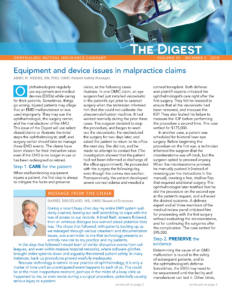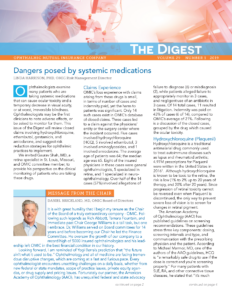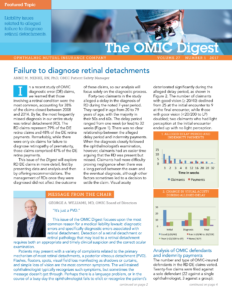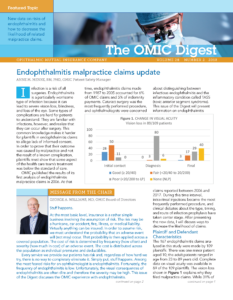Digest Vol 29 No 2 2019
 Ophthalmologists regularly use equipment and medical devices (EMDs) while caring for their patients. Sometimes, things go wrong. Injured patients may allege that an EMD malfunctioned or was used improperly. They may sue the ophthalmologist, the surgery center, and the manufacturer of the EMD.
Ophthalmologists regularly use equipment and medical devices (EMDs) while caring for their patients. Sometimes, things go wrong. Injured patients may allege that an EMD malfunctioned or was used improperly. They may sue the ophthalmologist, the surgery center, and the manufacturer of the EMD.
This issue of the Digest will use select closed claims to illustrate the initial steps the ophthalmologist, staff, and surgery center should take to manage these EMD events. The claims have been chosen for their instructive value even if the EMD is no longer in use or has been redesigned or retired.
Digest Vol 29 No 1 2019
 Ophthalmologists examine many patients who are taking systemic medications that can cause ocular toxicity and a temporary decrease in visual acuity, or at worst, irreversible blindness.
Ophthalmologists examine many patients who are taking systemic medications that can cause ocular toxicity and a temporary decrease in visual acuity, or at worst, irreversible blindness.
Ophthalmologists may be the first clinicians to note adverse effects, or be asked to monitor for them. This issue of the Digest will review closed claims involving hydroxychloroquine, ethambutol, gentamicin, and amiodarone, and suggest risk reduction strategies for ophthalmic practices to implement.
Digest Vol 28 No 2 2018
Infection is a risk of all surgeries. Endophthalmitis is a particularly worrisome type of infection because it can lead to severe vision loss, blindness, and loss of the eye. Some types of complications are hard for patients to understand. They are familiar with infections, however, and realize that they can occur after surgery. This common knowledge makes it harder for plaintiffs in endophthalmitis claims to allege lack of informed consent.
In order to prove that their outcome was caused by malpractice and not the result of a known complication, plaintiffs must show that some aspect of the health care team’s treatment was below the standard of care.
OMIC published the results of its first analysis of endophthalmitis malpractice claims in 2006. At that
time, endophthalmitis claims made from 1987 to 2005 accounted for 6% of OMIC claims and 5% of indemnity payments. (read more…)
Digest Vol 27 No 1 2017
 In a recent study of OMIC diagnostic error (DE) claims, we learned that those involving a retinal condition were the most common, accounting for 38% of the claims closed between 2008 and 2014. By far, the most frequently missed diagnosis in our entire study was retinal detachment (RD). The RD claims represent 79% of the DE retina claims and 48% of the DE retina payments. Remarkably, while there were only six claims for failure to diagnose retinopathy of prematurity, those claims comprised 47% of the DE retina payments. Read more…
In a recent study of OMIC diagnostic error (DE) claims, we learned that those involving a retinal condition were the most common, accounting for 38% of the claims closed between 2008 and 2014. By far, the most frequently missed diagnosis in our entire study was retinal detachment (RD). The RD claims represent 79% of the DE retina claims and 48% of the DE retina payments. Remarkably, while there were only six claims for failure to diagnose retinopathy of prematurity, those claims comprised 47% of the DE retina payments. Read more…







